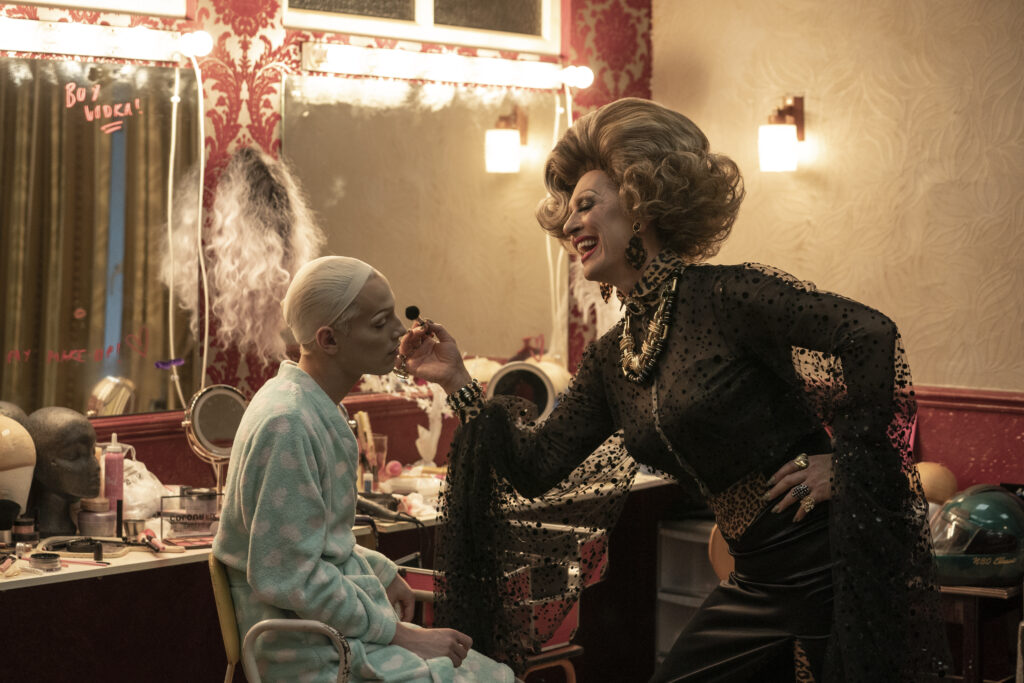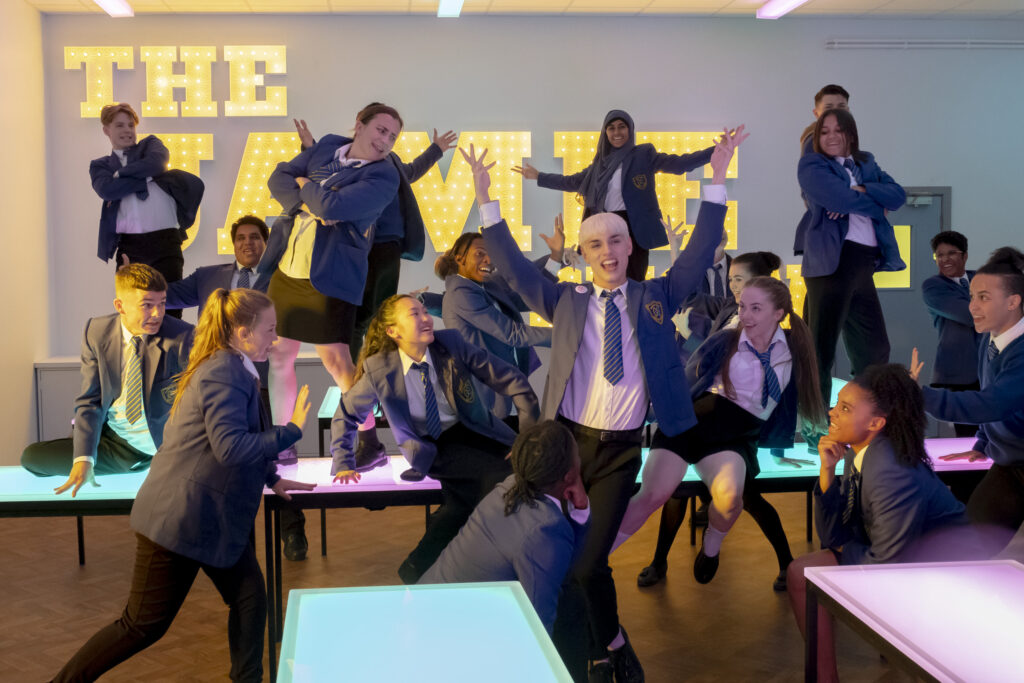In ‘Everybody’s Talking About Jamie,’ the veteran actor plays a gay warrior queen who inspires a young drag artist
By Chris Azzopardi
On the heels of his Oscar-nominated role as Jack Hock in “Can You Ever Forgive Me?” alongside Melissa McCarthy, actor Richard E. Grant takes on another aging gay man who embodies AIDS-era homosexuality. This time, though, the British actor’s character, Hugo Battersby, is literally in heels.
In “Everybody’s Talking About Jamie,” adapted from the coming-of-age British stage musical, Grant’s Hugo moonlights as Loco Chanelle, one of the most popular drag queens on the scene during a major turning point in the gay liberation movement, when AIDS devastated the LGBTQ+ community and forever changed the men, like Hugo, who lived through it.
He wasn’t just a drag queen — he was a warrior queen. Just the kind of figure Jamie (Max Harwood), the film’s titular character, needs as he navigates his young queer life as an aspiring queen whose bullies and school administration stand in the way of him being his true self.
Grant, also known for his roles in “Bram Stoker’s Dracula,” “Spice World” and “Gosford Park,” spoke about the role days before the heartbreaking passing of his wife, veteran Hollywood voice and dialect coach Joan Washington. In our interview, Grant talked about the major differences between Jack and Hugo, how bingeing 11 seasons of “RuPaul’s Drag Race” was his crash course in drag, and the unforeseen problem of being in costume and having to pee.

You look good in drag, Richard. It makes me think that, perhaps, you had a past in drag. Is that something that we should talk about?
Chris, this is entirely due to the amazing artwork of Guy Common, the makeup designer and applier; Nadia Stacey for the statue-like wig; and Guy Speranza, for his amazing costume of the double-D bra. That’s all their work. I can take no credit for this, whatsoever. They provided the armor for this.
Was it the double-D bra that really helped you get into character as Loco?
And six inch heels, leopard-skin tights and being 6’8″ and having to bend through doorways. That does something to your psyche. [Laughs.]
Did playing Loco have you considering your own drag name if, say, you were to compete on “RuPaul’s Drag Race”?
I think it would have to be Regina D’Lumpcious.
I look forward to the national tour.
Oh my god. I watched 11 series of “RuPaul’s Drag Race” in three weeks. I’ve never seen drag before, so I thought this was the best way of trying to immerse myself into the vulnerability and sheer steely determination that you have to have to live that life.
How did your crash course in drag prepare you to play Loco?
The vulnerability, on the one hand, and the incredible nerve that it takes, and then throwing shade and sass, and that every single drag artist had some prejudice to overcome, either within their own family or in society. So I thought that the courage that they have is absolutely extraordinary. They may be crying backstage or having a meltdown or some tragedy has happened, and yet, they go onstage in all this gear and just deliver. And I felt that was really key to Hugo/Loco. These two sides, it’s so extreme.
Hugo’s story is one of resilience — he lived through the AIDS epidemic, lost a lot of friends to the virus, including his partner — and Jamie recognizes that.
He’s kind of an emotional anchor and [there’s] the historical overview too, because Jamie is out happily at the age of 16. His real struggle is convincing the school to accept him in drag, which is a very different journey from what Hugo has gone through with Stonewall, the hedonism of the ’70s and the legalization of homosexuality, certainly, in the UK in 1967, which is a historical blink away. Then followed by this scourge of AIDS in the ’80s and ’90s, where you know generations of people were wiped out. It’s such a different struggle than what Jamie knows and is going through. And I thought that being done in a montage with a song called “This Was Me” was a very smart way of bringing that historical context into the movie.

How do you know so much LGBTQ+ history?
Where I grew up in this tiny country in Southeast Africa, I don’t recall ever meeting anybody that I knew was gay. But certainly, when I went to drama college and university and going into the theater, there are many gay people. So, I suppose by osmosis and accumulation of people that you are surrounded by. So many designers and makeup artists and costume designers in my career experience have been gay. I think that informs you. People who had the best parties or the best clothes or the best music choices, they were the people that, in my experience, were gay.
So it seemed like the chosen people compared to the rest of us, who were wearing slouchy clothes or not having good taste, which I know is playing to a complete cliché.
I was also friends with an actor called Ian Charleson, who played the lead in “Chariots of Fire” in the early ’80s. He died of AIDS in 1990. I’ve worked with him a couple of times. So he was really the inspiration for how I approached playing Jack Hock in “Can You Ever Forgive Me?” Then I went to RuPaul’s school on TV to try and learn how to play Hugo Battersby/Loco Chanelle. So I think that you can’t work in show business and not be educated by gay people. You’d have to be in a universe of only doing action movies with hyper-machismo people to not be aware.
A couple of years ago you said it was “unjustifiable” when straight actors play gay roles, which has obviously been an ongoing conversation in the business. But you’re gay in this movie.
It’s the first thing I said to [director] Jonathan Butterell when he offered me this part. I said, “You should cast a drag artist or an openly gay actor to play this part because you and I are gonna get into trouble for doing this.” And he said, “The creative team are all gay, and we have decided you have sad eyes, and we think that you’re right for this part.” So I said, “Well, you know, if it comes down on your head or mine that you should have cast a gay actor, be warned.” But he was very determined.
Do you think Jack and Hugo would be friends if they met on the street?
I think that Jack is such a gregarious huckster, and chances are that he never saw himself as a failure. Whereas, I think that Hugo knows that he’s a failure. And he’s lost his partner. Jack had lost his partner, as well, but there is something innately optimistic about him, about Jack Hock, that is what makes him ludicrous and funny and vulnerable. Whereas Hugo is until he meets Jamie, who really ignites his love of drag and gives him a kind of brief second act in his life.
I think that Jack Hock would probably think that Hugo was a sad, old has-been [laughs] and not worth bothering with. And certainly, because he had no money. Jack was entirely obsessed with anybody who was gonna give him a drug deal or a free meal or a sofa. Hugo doesn’t have anything to offer. He would just think he was a sad, old queen. (laughing) He would have no time for him, definitely.
If there’s another straight guy out there who wants to transform into drag, what tips can you offer?
Go on a diet. [Laughs.] And when you’re in drag and tucked, be warned in advance that you can’t eat or drink anything other than tiny sips through a straw because the [work] that it takes to get out of all that gear to go and have a wee is so monumental that you have to develop the thinking and the physicality of a camel’s bladder.
It doesn’t sound like a very pleasant experience when you describe it like that.
It’s extremely uncomfortable.
Is this the first time that you’ve walked in heels that high?
Yeah, first time I’ve been in drag.
Well, I mean, you can still walk in heels without being in drag, Richard.
True. I’m a teenager of the ’70s so I had platform heels, but not as high as these were.
How tall were those?
Oh, four inches.
Did you manage to stay up on them? No accidents?
Oh yeah, because the wedges of those ones, in the ’70s, were like two inches square. These drag shoes were stiletto heels. Torture chambers. Have you been in drag?
Not full-on drag.
Well, there’s always tonight.

This interview has been condensed and edited for clarity
Chris Azzopardi is the Editorial Director of Pride Source Media Group and Q Syndicate, the national LGBTQ+ wire service. He has interviewed a multitude of superstars, including Cher, Meryl Streep, Mariah Carey and Beyoncé. His work has also appeared in The New York Times, Vanity Fair, GQ and Billboard. Reach him via Twitter @chrisazzopardi.
